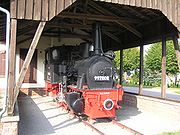
Baden C
Encyclopedia
The Baden C was a six-wheeled, narrow gauge, tank locomotive designed for the metre gauge
line from Mosbach to Mudau.
. The frame
was designed as a water tank. Due to the steep inclines it had a large boiler, the boiler barrel consisting of two shells.
It had an Allan valve gear with trick valves. The connecting rods drove the third coupled wheels. The loco had an
Exter counterweight brake for the engine and a Körting vacuum brake
for the train. This was probably replaced in 1926 by a Westinghouse compressed-air brake. When the Deutsche Reichsbahn
took over the operational running of the state-owned by privately operated line from the Deutsche Eisenbahn-Betriebsgesellschaft, a subsidiary of the firm of Vering & Waechter who had built the line, these engines were incorporated into their fleet as numbers 99 7201 to 99 7204. In 1964/1965 the steam locomotives were retired and replaced by diesel locomotives. Until then they had managed all the traffic, no other locomotives were even employed in a temporary role.
 All the locomotives have been preserved until the present day.
All the locomotives have been preserved until the present day.
Metre gauge
Metre gauge refers to narrow gauge railways and tramways with a track gauge of . In some African, American and Asian countries it is the main gauge. In Europe it has been used for local railways in France, Germany, and Belgium, most of which were closed down in mid 20th century. Only in Switzerland...
line from Mosbach to Mudau.
History
The four locomotives were built in 1904 by the firm of BorsigAugust Borsig
Johann Friedrich August Borsig was a German businessman who founded the Borsig-Werke factory.Borsig was born in Breslau , the son of cuirassier and carpenter foreman Johann George Borsig...
. The frame
Locomotive frame
A locomotive frame is the structure that forms the backbone of the railway locomotive, giving it strength and supporting the superstructure elements such as a cab, boiler or bodywork. The vast majority of locomotives have had a frame structure of some kind...
was designed as a water tank. Due to the steep inclines it had a large boiler, the boiler barrel consisting of two shells.
It had an Allan valve gear with trick valves. The connecting rods drove the third coupled wheels. The loco had an
Exter counterweight brake for the engine and a Körting vacuum brake
Vacuum brake
The vacuum brake is a braking system employed on trains and introduced in the mid-1860s. A variant, the automatic vacuum brake system, became almost universal in British train equipment and in those countries influenced by British practice. Vacuum brakes also enjoyed a brief period of adoption in...
for the train. This was probably replaced in 1926 by a Westinghouse compressed-air brake. When the Deutsche Reichsbahn
Deutsche Reichsbahn
Deutsche Reichsbahn was the name of the following two companies:* Deutsche Reichsbahn, the German Imperial Railways during the Weimar Republic, the Third Reich and the immediate aftermath...
took over the operational running of the state-owned by privately operated line from the Deutsche Eisenbahn-Betriebsgesellschaft, a subsidiary of the firm of Vering & Waechter who had built the line, these engines were incorporated into their fleet as numbers 99 7201 to 99 7204. In 1964/1965 the steam locomotives were retired and replaced by diesel locomotives. Until then they had managed all the traffic, no other locomotives were even employed in a temporary role.
Preserved

- 99 7201 stood for a long time as a monument near Passau, before being acquired in 2007 by the Hirzbergbahn.
- 99 7202 is a monument at MudauMudauMudau is a municipality in the Neckar-Odenwald district, Baden-Württemberg, Germany. it has 5,099 inhabitants.-Geography:Mudau lies in the southeastern Odenwald mountains between the Neckar and Main rivers, 75 km southeast of Frankfurt am Main and 40 km northeast of Heidelberg...
station. - 99 7203 was used by the Albtalbahn from 1964 to 1966 for maintenance of way duties. It then went to the Karlsruhe gasworks and, later the Viernheim narrow gauge museum. Finally it ended up with the Ulmer Eisenbahnfreunde and has been in museum railway service since 1990 on the Amstetten–Oppingen line.
- 99 7204 was stored at OberbernbachAichachAichach is a town in Germany, located in the Bundesland of Bavaria and situated just northeast of Augsburg. It is the capital of the district of Aichach-Friedberg. The municipality of Aichach counts some 20,000 inhabitants. It isn't far from the motorway that connects Munich and Stuttgart, the A8....
in Bavaria for a long time before being transferred in 1999 to the Märkische Museum RailwayMärkische Museum RailwayThe Märkische Museum Railway or MME is a German railway society that was founded in order to show narrow gauge vehicles in operation on small branch lines.- History :...
in PlettenbergPlettenbergPlettenberg is a town in the Märkischer Kreis, in North Rhine-Westphalia, Germany.-Geography:Plettenberg is located in the east of the Sauerland hills. The highest elevation of the city area is in the Ebbegebirge with 593 m above sea level, the lowest elevation with 194 m near Teindeln...
.
Sources
- Josef Högemann: Schmalspurbahn Mosbach - Mudau.Verlag Kenning, Nordhorn 1993, (Nebenbahndokumentationen 5), ISBN 3-927587-15-X
- Horst J. Obermayer: Taschenbuch Deutsche Schmalspur-Dampflokomotiven. Franckh, Stuttgart 1971, ISBN 3-440-03818-1
- Alexander Neumann: 99 7201-7204. Vier Dampfloks begehen ihren Hundertsten. in: Die Museumseisenbahn 3/2004, S. 10-21. ISSN 0936-4609
External links
- There is a relevant English-language forum at Railways of Germany

